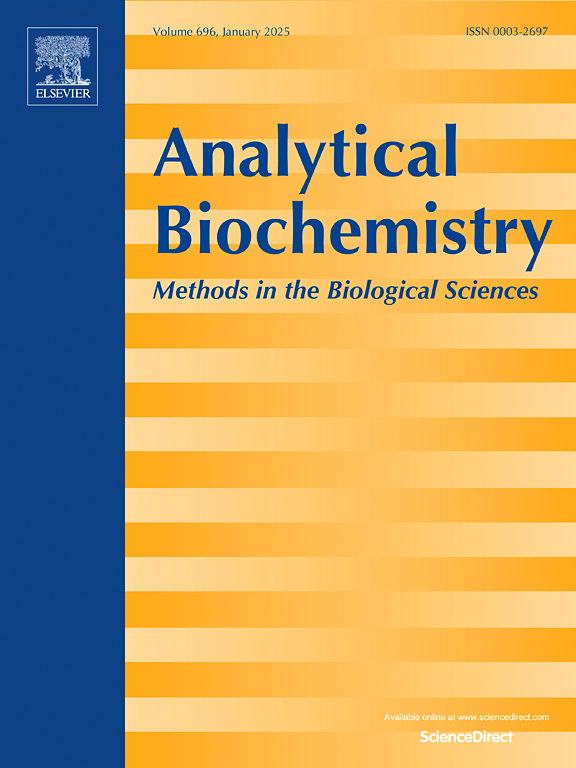Rapid, flexible fabrication of a microfluidic electrochemical chip nucleic acid target for selective, label-free detection of influenza virus DNA using catalytic redox-recycling
IF 2.6
4区 生物学
Q2 BIOCHEMICAL RESEARCH METHODS
引用次数: 0
Abstract
H5N1 flu is a highly virulent and variable subtype of influenza with significant epidemic and pandemic potential. In this study, we introduce a novel, maskless, and rapid manufacturing process for a microfluidic chip integrated with electrodes for the quantitative detection of H5N1-DNA sequences. This detection leverages a catalytic redox-recycling signal via a novel Fe₃O₄@TMU-8 nanocomposite, which facilitates the turnover of the oxidation state of [Ru(NH₃)₆]³⁺, thereby amplifying the electrochemical signal output. The positively charged [Ru(NH₃)₆]³⁺ molecule associates with the phosphate backbone of the nucleic acids in H5N1-DNA. Changes in the aptasensor's redox-recycling signal, due to the hybridization of DNA sequences with [Ru(NH₃)₆]³⁺, were used as the electrochemical sensing response. Under optimal conditions, the signal exhibited a linear relationship with H5N1-DNA concentration, ranging from 1 fM to 1 nM, with a detection limit of 0.16 fM. This report details the fabrication of the microfluidic device using Poly(methyl methacrylate) (PMMA) sheet substrates. A laser system was employed to generate microfluidic patterns directly on the PMMA sheet. This biosensing device demonstrated long-term stability and good reproducibility, making it suitable for the quantitative assay of H5N1-DNA sequences. The results from food sample analyses further confirmed the applicability and effectiveness of the resulting biosensor.

利用催化氧化还原循环快速、灵活地制备用于流感病毒DNA选择性、无标记检测的微流控电化学芯片核酸靶标。
H5N1流感是一种高毒力和可变的流感亚型,具有显著的流行和大流行潜力。在这项研究中,我们介绍了一种新的、无掩模的、快速制造的微流控芯片集成电极,用于定量检测H5N1-DNA序列。这种检测利用了一种新型Fe₃O₄@TMU-8纳米复合材料的催化氧化还原回收信号,促进了[Ru(NH₃)₆]³⁺氧化态的转换,从而放大了电化学信号输出。带正电的[Ru(NH₃)₆]³+分子与H5N1-DNA中核酸的磷酸主链结合。由于DNA序列与[Ru(NH₃)₆]³⁺杂交,偶联传感器的氧化还原回收信号发生了变化,这被用作电化学传感响应。在最佳条件下,该信号与H5N1-DNA浓度呈线性关系,范围为1 fM ~ 1 nM,检出限为0.16 fM。本报告详细介绍了使用聚甲基丙烯酸甲酯(PMMA)片基板的微流控装置的制造。采用激光系统直接在PMMA薄片上产生微流控图案。该生物传感装置具有长期稳定性和良好的重复性,适用于H5N1-DNA序列的定量分析。食品样品分析的结果进一步证实了该生物传感器的适用性和有效性。
本文章由计算机程序翻译,如有差异,请以英文原文为准。
求助全文
约1分钟内获得全文
求助全文
来源期刊

Analytical biochemistry
生物-分析化学
CiteScore
5.70
自引率
0.00%
发文量
283
审稿时长
44 days
期刊介绍:
The journal''s title Analytical Biochemistry: Methods in the Biological Sciences declares its broad scope: methods for the basic biological sciences that include biochemistry, molecular genetics, cell biology, proteomics, immunology, bioinformatics and wherever the frontiers of research take the field.
The emphasis is on methods from the strictly analytical to the more preparative that would include novel approaches to protein purification as well as improvements in cell and organ culture. The actual techniques are equally inclusive ranging from aptamers to zymology.
The journal has been particularly active in:
-Analytical techniques for biological molecules-
Aptamer selection and utilization-
Biosensors-
Chromatography-
Cloning, sequencing and mutagenesis-
Electrochemical methods-
Electrophoresis-
Enzyme characterization methods-
Immunological approaches-
Mass spectrometry of proteins and nucleic acids-
Metabolomics-
Nano level techniques-
Optical spectroscopy in all its forms.
The journal is reluctant to include most drug and strictly clinical studies as there are more suitable publication platforms for these types of papers.
 求助内容:
求助内容: 应助结果提醒方式:
应助结果提醒方式:


